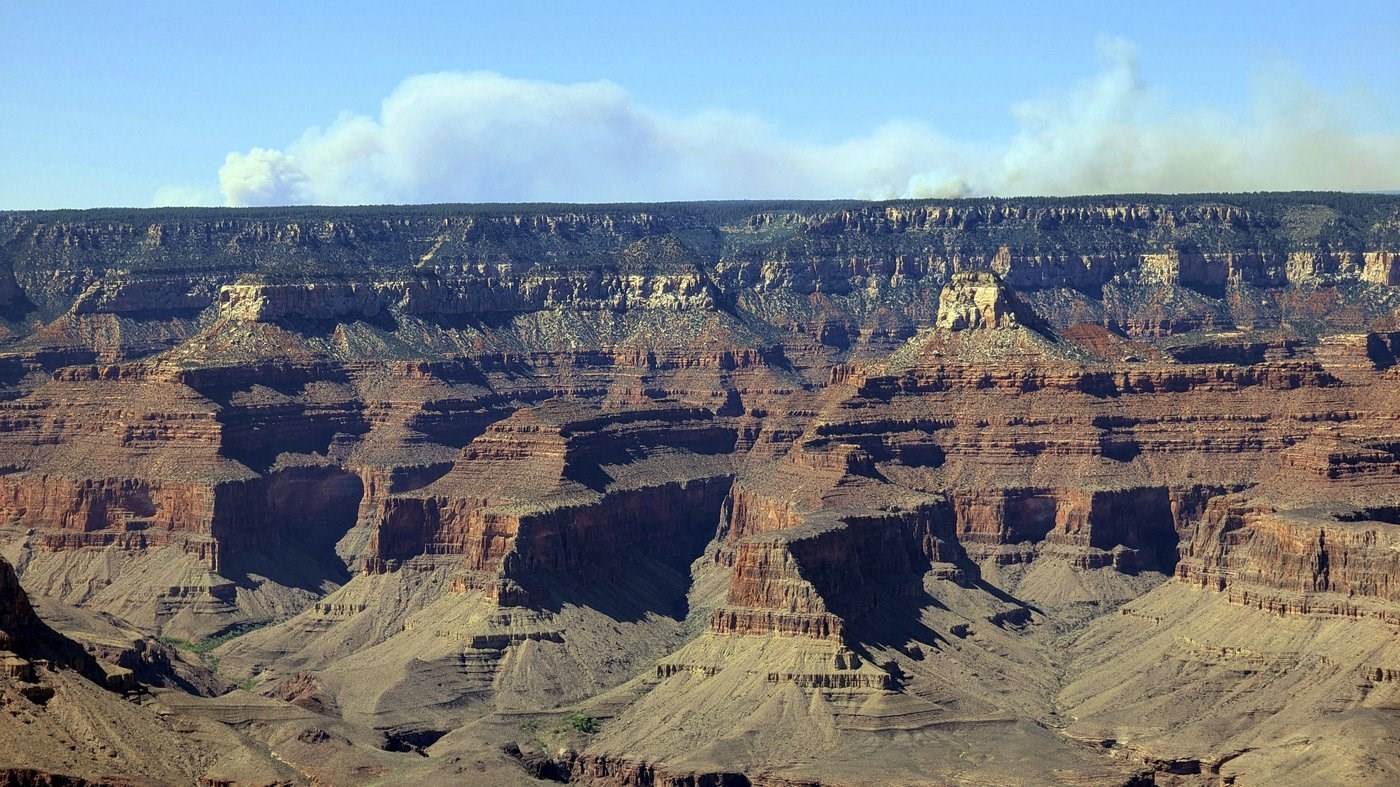
This image provided by Eddie Vallee and taken from the South Rim of Grand Canyon National Park in northern Arizona shows smoke over the park's North Rim on Thursday, July 10, 2025.(Eddie Vallee via AP)
July 14, 2025 - 3:18 PM
Nearly 5 million people visited the Grand Canyon last year, from day trippers and campers to people sleeping overnight in historic lodges and cabins.
This year will be different, at least for one portion of the park. A wildfire has torn through a historic lodge and ended the season for the canyon's North Rim, a place where visitors could find less bustle in one of the country's most iconic national parks.
As firefighters continue to fight the blaze, here's what to know about Grand Canyon National Park.
Bigger than Rhode Island
The Colorado River cuts through Grand Canyon National Park for about 278 miles (447 kilometers), pushing across northwestern Arizona. The eastern boundary is near the state’s northern border with Utah, while the western edge is near Nevada.
Grand Canyon National Park is about 1,900 square miles (nearly 5,000 square kilometers), according to the National Park Service, which makes it bigger than Rhode Island.
The park is unique because of its canyon walls, which boast horizontal layers of red, orange and purple rock. The average depth of the iconic formation is about a mile (1.6 kilometers), while the average width is about 10 miles (16 kilometers).
“Four Empire State Buildings stacked one atop the other would not reach the rim,” Lance Newman wrote in the introduction to the 2011 book, “The Grand Canyon Reader.”
The north and south rims
Within the park are the north and south rims, which are the primary travel destinations because of their accessibility.
The North Rim receives 10% of park visitors and is known for more quiet and solitude, according to the park service. It's open from mid-May to mid-October because of the snow. But the wildfires have closed it for the rest of the season, destroying a historic lodge and dozens of cabins.
The South Rim is open all year. It's more bustling and boasts a historic district, which dates to when the first steam-powered train arrived in 1901.
A car trip between the rims takes five hours, according to the park service. That's because there's only one way across the Colorado River by vehicle, and its 137 miles (231 kilometers) from the South Rim Village.
Hiking between rims is a shorter distance, 21 miles (34 kilometers), though by no means easy. It includes crossing the river on a narrow foot bridge 70 feet (21 meters) above the water.
Unexplored by Europeans for 235 years
The Grand Canyon was formed with the shifting of tectonic plates, which lifted layers of rock into a high and relatively flat plateau, according to the park service. About 5 million to 6 million years ago, the Colorado River began to carve its way downward, slowly deepening and widening the gorge.
The oldest human artifacts in the area date to about 12,000 years ago, when small bands of people hunted bison, the park service said. There were gradual shifts to agriculture, the building of pueblos and the development of trade routes. Today, 11 tribes have historic connections to the canyon, including the Hopi and the Diné (Navajo).
The Spanish were the first Europeans to the see the Grand Canyon in 1540, according to the park service. Francisco Vázquez de Coronado and his Spanish army were searching for fabled cities of gold.
“The Hopi were able to fool the Spaniards into thinking that the area was an impenetrable wasteland and was not navigable anyway,” the park service wrote on its website, adding that the canyon “was left unexplored by Europeans for 235 years.”
In the late 1850s, an Army lieutenant explored the Grand Canyon in search of a viable trade route, the park service said. Joseph Christmas Ives described it as “altogether valueless" and predicted it “shall be forever unvisited.”
The Grand Canyon began to draw much more interest after expeditions in 1869 and 1871 by geologist John Wesley Powell.
Powell described rock layers in the canyon’s towering walls: "creamy orange above, then bright vermilion, and below, purple and chocolate beds, with green and yellow sands.”
‘You cannot improve on it’
As the years went on, more explorers arrived by boat, on foot and on horseback, often with the help of Native American guides. Wealthy travelers came by stagecoach from Flagstaff to the South Rim in the 1880s. After the arrival of trains, the automobile became the more popular mode of travel in the 1930s.
Early entrepreneurs charged $1 to hike down the Bright Angel Trail used by the Havasupai people whose current-day reservation lies in the depths of the Grand Canyon.
President Woodrow Wilson signed legislation to create the park in 1919 but Teddy Roosevelt is credited for its early preservation as a game reserve and a national monument.
He famously said: “Leave it as it is. You cannot improve on it. The ages have been at work on it, and man can only mar it.”
News from © The Associated Press, 2025